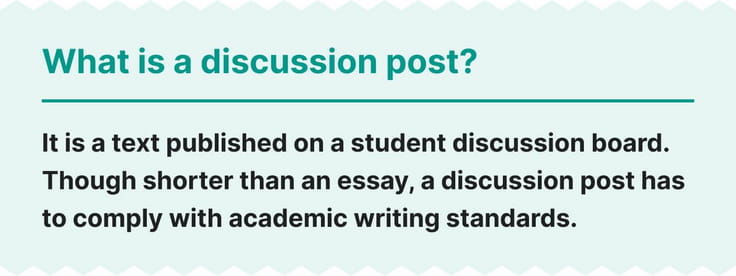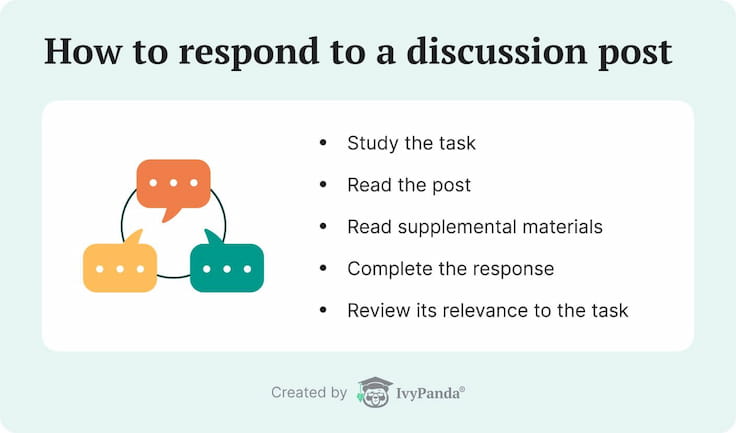Free Discussion Board Response Generator
⚙️ Discussion Board Reply Generator – How to Use It?
Our free discussion board response generator is user-friendly and straightforward. Just follow the steps indicated below:
First, choose if you want to generate a discussion board post or a reply to your classmate’s post.
If you want to get a post:
- Add the question from your teacher; it should be 5 to 100 words long.
- Specify if you need to mention the class readings in your post.
- Insert the readings into the text box if you have them; note that they shouldn’t exceed 2,000 words. Consider using the free summarizing tool if your readings are longer.
- Choose if you want a follow-up question at the end of the post.
If you want to get a reply:
- Paste your classmate’s discussion post in the provided tab. It may be anywhere from 50 to 500 words long.
- Indicate in the next section whether you agree or disagree with your classmate’s content. If you don’t tick any option, the default variant will be “agree.”
- Click on “Advanced Settings” and indicate specific issues you agree or disagree with.
- Get the result in several seconds by clicking on the “Generate” tab.
As you can see, things work pretty simply with our discussion board reply generator. You just need to do a couple of actions, and the tool will prepare a well-organized response in line with your classmate’s discussion board content.
📝 What Is a Discussion Post?
A discussion post is quite a short text published on a student discussion board.

Discussion posts are often used in any learning course because:
- They allow the professor to check whether you understand the materials correctly.
- They are a vital barometer of the student’s participation in the class.
- They don’t take too much time or space and can’t be treated as regular essays.
Though easier to write than ordinary essays, discussion board posts still have to comply with the standards of coherent and informative academic writing.
A typical discussion post should have a central argument or idea you’re looking at, and it should also offer concrete evidence (sometimes with sources) to substantiate that point.
📑 Discussion Post Structure
Now, let’s talk about the generic structure a discussion post should follow.
The rule of thumb is to have 3 main elements in this piece of writing:
- An answer to the professor’s original question
- Supporting evidence for that answer
- A final interpretation of how your evidence links to the question
How to end a discussion post?
This question often troubles students, as they usually need to formulate a thought-provoking question that would fuel further discussion of their raised topic. It’s not always required, but you can still encapsulate a rhetorical question or suggestion for further discussion in the concluding sentences of your discussion post.
💬 How to Respond to a Discussion Post?
If you’re new to discussion post responses, here are some simple steps to guide you through the process.

Here are the steps necessary to reply to a discussion board post:
Discussion board responses can differ in depth, revealing variations in topic mastery and academic proficiency.
Thus, if you want to impress the professor and create a deeper learning experience for your group, you may apply the following life hacks:
- Provide additional data to enrich the classmates’ understanding of the topic.
- Give an insightful commentary on the classmate’s approach and fuel a further discussion with an open-ended question.
- Evaluate the discussion post’s relevance or methodological rigor (if the latter applies to your subject). Talk about the relevance of the chosen specific issue within a broader topic and the quality of chosen supporting evidence.
🖋 How to Cite a Discussion Post in APA?
Citing a discussion post in the APA style follows basically the same approach as citing any other digital resource would:
- First, you should indicate the author’s name and the date of the post’s publication.
- Next comes the name of the discussion thread (the professor usually formulates it).
- Finally, you are expected to mention the resource where it is published (your university course’s directory).
Here is an example of the APA citation’s format:
James, K. (2022, Sep. 12). Re: Ethics of international business [Discussion post.] Walden University Blackboard. https://class.waldenu.edu
📋 Discussion Board Reply Examples
In this section, you’ll find a discussion board post example and a reply to it.
Discussion Board Post Example
Discussion question: What did you learn from the nursing theory course?
One of my major takeaways from this nursing theory course is that top-quality practice and continuous improvement of patient outcomes are impossible without evidence-based practice and ongoing research. Nurses, though often perceived only as supplementary medical staff, can become real change agents and quality improvement ambassadors in their clinical settings. All they need to do to attain these goals is to keep a sharp focus on the everyday practice from which they can collect data about their work and interactions with patients (Hoeck & Delmar, 2017). Once a specific health issue, gap, or problem is identified in the work setting, a nurse can apply their theoretical knowledge and research the variety of existing solutions to the existing problem to improve patient care outcomes and conditions.
I have learned in the course of studies and practice that evidence-based practice formation is a continuous cycle of data collection, critical analysis, and bridging of gaps between theory and practice in the nursing workplace. It takes time and effort, as nurses have to collect large amounts of data on a daily basis and subject them to academic scrutiny for the sake of new knowledge and practice generation. Yet, these efforts always pay off because they link nursing theory and practice and allow nurses to make a difference by delivering tangible, data-backed solutions to existing healthcare problems. These activities inevitably shape continuous healthcare service improvements, resulting in greater patient satisfaction.
Discussion Board Reply Example
I find Janie’s post very insightful and personal; I share many of her reflections on the process of nursing theory studies and months of nursing practice in the workplace setting. Indeed, as Mateo and Foreman (2013) confirmed, evidence-based practice is typically born out of the nurse’s careful and close attention to the details of nursing care they witness and deliver on a daily basis. Once a problem or inefficiency in care delivery is identified, a nurse may work this problem out by researching its fundamental causes and offering theory-backed solutions to improve the situation. This way, no evidence-based practice improvement can emerge in the nursing practice without a continuous cycle of meticulous data collection and assessment, reworking of all relevant theories underlying that issue, and the proposition of workable solutions based on solid clinical evidence. However, I would also note the typical challenges in the nursing practice, such as conceptualizing evidence in EBP and nurturing the critical thinking mindset among nurses that can enable continuous practice improvements.
Thank you for reading! We hope the information in this short guide to discussion board response writing was useful. Consider using these writing tools to speed up your work on any project: question generator from text, key points getter, notes generator, AI essay writer, and rhetorical analysis maker.
Updated: